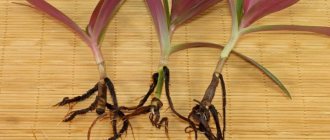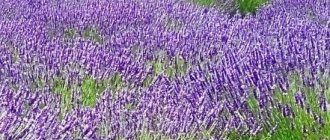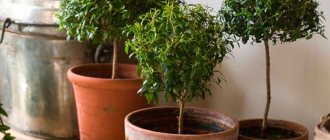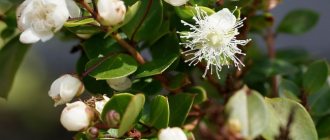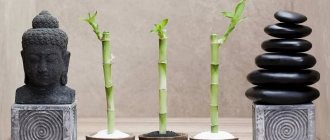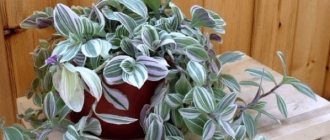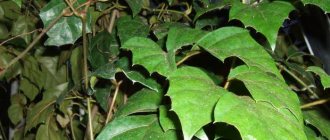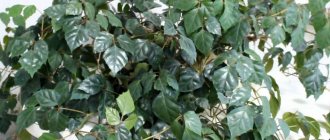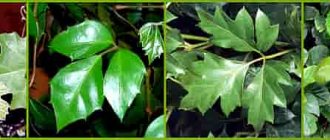Myrtle is an evergreen plant belonging to the Myrtaceae family. The translation of the name from Greek sounds like “balm”. The bush grows very slowly: a maximum of 10–15 centimeters per year. At the same time, the evergreen shrub is a long-liver. It is not uncommon to find 300-year-old trees.
The description says that the leaves of the bush are dark green, located on short petioles. A characteristic feature of the plant is the presence of glands that secrete essential oils, due to which a characteristic odor is noticeable when the leaf is rubbed.
In June-July, the bush is covered with white (less often pink) flowers, emitting a pronounced pleasant aroma. Flowering lasts until mid-autumn. After some time, black berries form in place of the flowers, which can be used as food. The berries ripen in November-December.
Outdoors, flowers are pollinated by insects. In the apartment they should be pollinated with a brush.
In nature, myrtle trees can be seen in southern Europe, western Asia, northern Africa, the Caribbean and the Azores.
The myrtle genus includes nearly 40 species, but only common myrtle (another name is communis) can grow in indoor conditions. In nature it can reach 5 meters in height, and indoors its height is 40–60 centimeters (occasionally a meter).
Based on the common myrtle, breeders have created several varieties that differ in height, color and leaf shape.
The most common varieties:
- variegata - characterized by two-color leaves;
- small-leaved - the leaves are small (up to 2 centimeters in length), the maximum plant height is 60 centimeters;
- large-leaved - the leaves are large (up to 5 centimeters in length), can grow up to three to four meters in height;
- Ralph - the flowers are pink and the berries are red.
Myrtle grows in nature:
- swamp (it is also known under other names - Cassandra, or Hamedaphne) - grows only near swamps, the leaves contain toxic substances and fall off in the winter;
- lush - distinguished by exfoliating bark;
- Luma is a giant that grows up to 25 meters in height;
- hequen is the most resilient.
How is Myrtle useful?
This plant can replace an entire pharmacy . When rubbed, the leaves emit a very strong odor that resembles the aroma of a coniferous tree. This smells like myrtle essential oil contained in the leaves of the plant. In addition to these oils, myrtle contains flavonoids, camphor, polyphenols, saponins and other substances.
has been used in folk medicine for a long time Tinctures, lotions, and decoctions are made from it.
Important: It is useful for the prevention and treatment of colds by simply chewing fresh myrtle leaves. Antimicrobial properties will help kill pathogens.
Myrtle in an apartment perfectly improves the health of the air. The leaves secrete phytoncides - substances that have bactericidal properties and destroy pathogenic microbes.
Surprisingly, a small tree can destroy up to 20% of streptococci and 40% of staphylococci.
The chemical composition of this amazing plant includes more than ten useful substances that have a beneficial effect on the human body.
A little history
Myrtle is traditionally cultivated in Mediterranean countries, where it often forms the dominant part of the vegetation. Roman legionaries tried to introduce myrtle, as a reminder of the homeland, into all the conquered countries, right up to Britain. But it was destined to come to Britain only in the second half of the 16th century, along with the orange tree.
The myrtle tree is a sacred attribute in many religions of the world.
In the myths of Ancient Greece, myrtle is associated with many deities - primarily with Aphrodite, the goddess of love and beauty. Groves of myrtle trees were planted around her temples. On the wedding day, the bride and groom, as well as the home, were decorated with myrtle wreaths. This tradition is firmly rooted in European countries. Queen Victoria rooted a sprig of myrtle from her wedding wreath, since then to this day myrtle has been a mandatory attribute of a wedding wreath in England; it was present at the wedding of Queen Elizabeth, Prince Charles and Diana Spencer, Prince William and Kate Middleton. Homes are decorated with myrtle trees on a wedding day in France.
A wreath made of myrtle tree branches also served among the Greeks as a symbol of power and veneration. From the ancient Greeks, the worship of the myrtle tree passed to the Romans and was associated with the goddess Venus.
The myrtle tree is mentioned many times in the Bible. Among the ancient Jews, myrtle was a symbol of peace and justice. To this day, it is one of the four sacred plants used during the Jewish Feast of Tabernacles (Sukkot). In Christianity, myrtle is associated with the name of the Virgin Mary. In all religions it serves as a symbol of love, beauty, peace, purity and hope.
Medicinal properties or treatment of myrtle
- strengthens the immune system;
- helps in the treatment of colds;
- used for diseases of the upper respiratory tract;
- has a wound healing effect;
- is a natural antiseptic;
- has an analgesic effect;
- successfully fights various tumors;
- excellent antiallergic agent.
And this is not the entire list of beneficial properties of this plant.
Myrtle oil is also successfully used in cosmetology.
Cosmetics using this oil moisturize and nourish the epidermis, treat problematic skin with acne. This essential oil also strengthens hair and improves hair structure.
- For skin diseases, lotions made from myrtle decoction are successfully used;
- If you have a sore throat, rinsing with this decoction will bring noticeable relief and a quick positive effect. Such rinses will be especially helpful for children;
- Myrtle infusion will help in the treatment of herpes. To do this, apply a cotton pad moistened with infusion to the affected area;
- For eye diseases, apply lotions from myrtle infusion directly to the eyes, and also take the healing tincture internally;
- An alcohol tincture with myrtle will help with purulent otitis media, bronchitis, pneumonia, etc.;
- 5 drops of myrtle oil dissolved in hot water is an excellent remedy for inhalation for colds;
- Rubbing myrtle oil into the gums will help with periodontal disease;
- Myrtle oil is a good rubbing remedy for various colds.
Indications for use
Medicines based on myrtle have a wide range of effects. They can be used in the treatment of influenza, to prevent its development, and to treat complications arising after influenza. Myrtle preparations produce a mild effect on the body. In addition to the treatment of oncological diseases, taking into account its excellent phytoncidal, bactericidal, immunostimulating properties, tinctures and leaves can be used for the treatment of bronchitis, asthma, tuberculosis, diphtheria, sinusitis, heart disease, brain, throat, blood, gastrointestinal diseases (hemorrhoids, pyelonephritis, cystitis, dysbacteriosis ).
Myrtle tincture is often used for prostatitis.
Myrtle is most effective in the treatment of pathologies of the lungs (bronchitis, emphysema), bronchi, intestines, blood, sinusitis and allergic reactions.
The positive impact develops in a short period of time.
Myrtle tinctures and decoctions based on it can be effectively combined with other medicinal herbs intended for the treatment of the gastrointestinal tract and lungs. Myrtle is one of the best remedies for the treatment of many diseases affecting internal organs and having an infectious and inflammatory nature. The remedy is quite effective for external inflammatory processes - fistulas, purulent wounds, herpes zoster, acne. Myrtle tincture has proven itself in the treatment of diseases in the oral cavity and periodontal disease. It is often used by dentists in their practice. By daily rinsing the mouth with myrtle tincture, you can stop decay processes, for example, caries. Also, daily use of myrtle tincture will effectively prevent the development of many diseases. Traditional medicine recommends the use of myrtle for pathologies of the bladder, intestines, gynecology, and prostatitis.
So, let's look at the beneficial properties of myrtle tincture.
ANTI-TUBERCULOSIS PROPERTIES
Myrtle is especially effective in the treatment of tuberculosis. As our practice shows, myrtle, especially in combination with Juglone, significantly accelerates recovery, and additional use of the probiotic fermented milk starter “Kurunga” strengthens the patient’s immunity. As you know, tuberculosis is practically not treated with antibiotics, and myrtle will provide the greatest help here. This is due to the content of volatile essential oils in myrtle, including eugenol. The antiseptic and antimicrobial properties of eugenol have been used for a long time. Modern research allows us to classify eugenol as a tuberculostatic agent: they stop the growth of Mycobacterium tuberculosis in vitro at a concentration of 1:8000.
Diseases and pests of myrtle
- One of the most unpleasant pests is the scale insect. Due to the fact that the plant has many small leaves, manually getting rid of it is problematic. An effective option would be radical pruning. Such an event will remove most of the scale insects and provide access to difficult places for processing. Then the bush is treated with drugs.
- Spider mites reveal themselves by yellowing and falling leaves.
- Traditional methods or acaricides are used against ticks.
An educational video will show you how to care for indoor myrtle.
The most popular types and varieties of myrtle
The following types of myrtle are kept indoors. Photo below.
Common myrtle
It has a short trunk covered with scaly, peeling bark. The leaves are brilliantly located opposite each other. The flowers are white with long yellow stamens protruding beyond the corolla.
At home, both the botanical species and varieties of common myrtle are grown.
The following varieties are most commonly found.
Tarentina
A low-growing variety characterized by dwarf size and abundant flowering.
Variegata
The leaves differ in color; they are variegated, green and white.
Chilean myrtle (Luma apiculata)
This species is represented by slowly growing trees reaching 10 - 20 meters in height. The trunks are twisted, with smooth bark. The berries of Chilean myrtle are edible and have medicinal properties, which is why they are used in medicine.
Dwarf forms are grown as indoor plants.
Glanleam Gold
Variegated form of Chilean myrtle. It is small in size.
Pruning and crown formation
It sounds intimidating, but in fact, shaping myrtle is easier than it seems: it is a very flexible shrub. It is enough to simply trim with scissors or pluck leaves that, as you think, disturb the appearance of the plant and make it untidy and unattractive.
Don't be afraid of pruning: it only stimulates more intensive growth of a denser crown.
When is the best time to prune: after flowering, best in mid-spring.
Myrtle bonsai
Formally, this is, of course, not a bonsai. A bonsai is a tree that was supposed to grow large (pine, oak, ash...), but was grown in a certain way, essentially with constant suppression of the root system in such a way that it grew miniature.
However, myrtle can be shaped so that it looks like a bonsai, that is, like a small tree. To do this, you need to constantly pluck the lower leaves to form a trunk, and then maintain the correct shape of the crown. If the trunk is not thick enough to look like a tree, you need to cut off the top - this will stimulate the thickening of the trunk.
In order to direct the branches in the desired direction, for a more complex bonsai shape, wire is used: you need to wrap the branch with it, giving it the desired direction.
Reviews of myrtle tincture
Reviews about the experience of using the product are not very common, but they all indicate the effectiveness of the product, in particular, for respiratory diseases and herpetic lesions. The undoubted advantage of the product is its natural composition, the possibility of self-production, and the low cost of pharmacy options. Separately, the almost complete absence of contraindications and the possibility of use in childhood are noted.
It is important to remember that when treating any disease, the use of additional drugs must be agreed with the attending physician. This will make the treatment effective and avoid the occurrence of negative symptoms or complications.
Myrtle tincture in the Nikitsky Botanical Garden can be found at a price of 270-300 rubles.
How to care for myrtle
The myrtle tree is quite picky in its content. Therefore, for successful growth, he is provided with proper care at home.
The soil
The plant prefers soil with high acidity. The mixture consists of the following components:
- turf land;
- compost soil or manure humus;
- peat;
- coarse sand.
All parts are taken in equal quantities.
This substrate is suitable for both adult plants and young seedlings.
Watering
- Water the plantings in a timely manner - even short-term drying out of the soil can trigger the shedding of leaves. If this happens, do not worry too much - the tree will grow again.
- Adding hydrogel to the soil will allow the soil to better retain moisture.
- It is useful to alternate watering with regular soft water and water acidified with lemon juice. To prepare the solution, add 2-3 drops of lemon juice to 1 liter of water.
- The home bush responds gratefully to spraying and cool showers.
Lighting, temperature
- The culture feels most comfortable in bright light, at moderate temperatures, about 18 - 23 C. The plant is covered from the scorching sun to prevent overheating. In summer it is taken out into the open air.
- The ideal option for keeping an indoor tree is a warm loggia or a bright, unheated room.
- Sometimes when Myrtus dries out, it is enough to take it into a cooler room to make it feel better.
- In winter, it is provided with a temperature of about 10 - 12 C. Watering for this period is limited, but without drying out the earthen coma.
Propagation of indoor myrtle
Myrtaceae propagate by cuttings and seeds.
Growing from seeds
The seeds must be fresh, their germination depends on this.
A mixture of the following composition is suitable for sowing:
- Peat soil;
- sand (vermiculite).
- Take the same amount of components and mix thoroughly. The result is a loose air mixture, which is watered with a fungicide solution (Fitosporin) to prevent fungal infections.
- The seeds are distributed over the surface of the substrate, then lightly sprinkled with a layer of soil.
- Cover with a transparent lid.
- The crops are periodically ventilated to prevent mold from appearing on the surface.
- The soil is kept moist.
- Shoots appear in 1 - 2 weeks, at a temperature not lower than 20 C. Bottom heating is desirable.
- After the true leaves appear, the seedlings must be transplanted into nutrient soil. Since the substrate in which the seeds sprouted is poor in nutrients.
Transplantation is stressful for young plants - they temporarily stop growing. But after adaptation, they begin to grow again.
Propagation by cuttings
When cutting, a non-lignified branch with a “heel” is separated from an adult tree. For successful rooting, the cut must be treated with stimulants: Epin, Zircon. Without the use of such phytohormones, attempts are doomed to failure.
Good results are achieved by using sphagnum moss. By its nature, it is breathable, retains water well, and most importantly, it has bactericidal properties and does not allow the shoots to rot.
Moss saturated with water is placed in a container and the treated cuttings are planted. The top is covered with a cap, which is periodically removed to ventilate.

